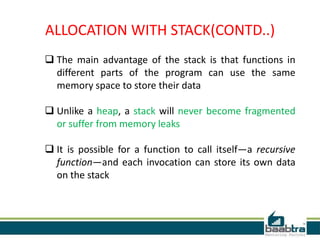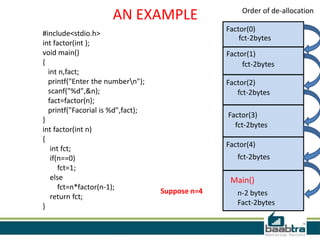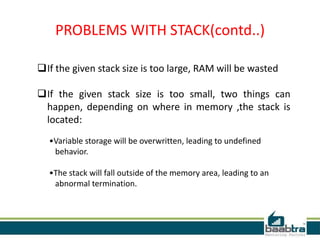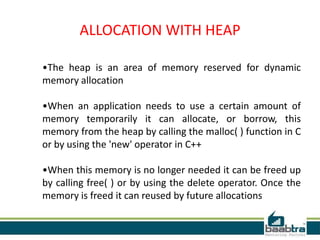Functions with heap and stack
- 2. Disclaimer: This presentation is prepared by trainees of baabtra as a part of mentoring program. This is not official document of baabtra –Mentoring Partner Baabtra-Mentoring Partner is the mentoring division of baabte System Technologies Pvt . Ltd
- 4. Functions with heap and stack Jaseena A P [email protected] www.facebook.com/Jaseena Muhammed A P twitter.com/username in.linkedin.com/in/profilena me 9539443588
- 5. WHAT IS THE STACK? The stack is a LIFO structure similar to packing items in a box •The last item placed into the box is the first item removed from the box. •However, the stack –like the box –has a fixed size and should NOT be overflowed. PUSH POP
- 6. WHAT IS THE HEAP? A heap is a binary tree T that stores a key-element pairs at its internal nodes It satisfies two properties: • MinHeap: key(parent) key(child) • [OR MaxHeap: key(parent) ≥ key(child)] • all levels are full, except the last one, which is left-filled
- 7. 4 6 207 811 5 9 1214 15 2516 WHAT IS THE HEAP?(contd..) EXAMPLE FOR A MIN HEAP
- 8. MEMORY What is memory? Huge linear array of storage How is memory divided? Kernel space and user space Who manages memory? OS assigns memory to processes Processes manage the memory they’ve been assigned
- 9. MEMORY ALLOCATION Memory allocation is a process by which computer programs and services are assigned with physical or virtual memory space. Memory allocation is primarily a computer hardware operation but is managed through operating system and software applications. Programs and services are assigned with a specific memory as per their requirements when they are executed. Once the program has finished its operation or is idle, the memory is released and allocated to another program or merged within the primary memory.
- 10. ALLOCATION WITH STACK When we have a declaration of the form “int a;”: a variable with identifier “a” and some memory allocated to it is created in the stack. The attributes of “a” are: • Name: a • Data type: int • Scope: visible only inside the function it is defined, disappears once we exit the function • Address: address of the memory location reserved for it. Note: Memory is allocated in the stack for a even before it is initialized. • Size: typically 2 bytes • Value: Will be set once the variable is initialized
- 11. Since the memory allocated for the variable is set in the beginning itself, we cannot use the stack in cases where the amount of memory required is not known in advance. This motivates the need for HEAP ALLOCATION WITH STACK(CONTD..)
- 12. The stack is a fixed block of memory, divided into two parts: •Allocated memory used by the function that called the current function, and the function called it etc. •Free memory that can be allocated The borderline between the two areas is called the top of stack and is represented by the stack pointer (SP), which is a dedicated processor register Memory is allocated on the stack by moving the stack pointer ALLOCATION WITH STACK(CONTD..)
- 13. very fast access ALLOCATION WITH STACK(CONTD..)
- 14. The main advantage of the stack is that functions in different parts of the program can use the same memory space to store their data Unlike a heap, a stack will never become fragmented or suffer from memory leaks It is possible for a function to call itself—a recursive function—and each invocation can store its own data on the stack ALLOCATION WITH STACK(CONTD..)
- 15. AN EXAMPLE #include<stdio.h> int factor(int ); void main() { int n,fact; printf("Enter the numbern"); scanf("%d",&n); fact=factor(n); printf("Facorial is %d",fact); } int factor(int n) { int fct; if(n==0) fct=1; else fct=n*factor(n-1); return fct; } Suppose n=4 Main() n-2 bytes Fact-2bytes Factor(4) fct-2bytes Factor(3) Factor(2) Factor(1) Factor(0) fct-2bytes fct-2bytes fct-2bytes fct-2bytes Order of de-allocation
- 16. PROBLEMS WITH STACK The way the stack works makes it impossible to store data that is supposed to live after the function returns. The following function demonstrates a common programming mistake. It returns a pointer to the variable x, a variable that ceases to exist when the function returns: int*MyFunction() { intx; /* Do something here. */ return &x; /* Incorrect */ }
- 17. PROBLEMS WITH STACK(contd..) Another problem is the risk of running out of stack. This will happen when one function calls another, which in turn calls a third, etc., and the sum of the stack usage of each function is larger than the size of the stack. (STACK OVERFLOW) •The risk is higher if large data objects are stored on the stack, or when recursive functions are stored.
- 18. AN EXAMPLE #include<stdio.h> int factor(int ); void main() { int n,fact; printf("Enter the numbern"); scanf("%d",&n); fact=factor(n); printf("Facorial is %d",fact); } int factor(int n) { int fct; fct=n*factor(n-1); return fct; } Main()-4 bytesSuppose n=4 Factor(4)-2 bytes Factor(3)-2 bytes Factor(2)-2 bytes Factor(1)-2 bytes Factor(0)-2 bytes Factor(-1)-2 bytes STACK OVERFLOW!!! 16bytes
- 19. PROBLEMS WITH STACK(contd..) If the given stack size is too large, RAM will be wasted If the given stack size is too small, two things can happen, depending on where in memory ,the stack is located: •Variable storage will be overwritten, leading to undefined behavior. •The stack will fall outside of the memory area, leading to an abnormal termination.
- 20. ALLOCATION WITH HEAP •The heap is an area of memory reserved for dynamic memory allocation •When an application needs to use a certain amount of memory temporarily it can allocate, or borrow, this memory from the heap by calling the malloc( ) function in C or by using the 'new' operator in C++ •When this memory is no longer needed it can be freed up by calling free( ) or by using the delete operator. Once the memory is freed it can reused by future allocations
- 21. ALLOCATION WITH HEAP(contd..) •Variables can be accessed globally •No limit on memory size •(Relatively) slower access •No guaranteed efficient use of space, memory may become fragmented over time as blocks of memory are allocated, then freed •Programmer must manage memory (he/she is in charge of allocating and freeing variables) •Variables can be resized using realloc()
- 22. AN EXAMPLE #include <stdio.h> int *sum(int *a,int *b) { int *c=malloc(sizeof(int)); /*find the sum here*/ return c;//return the sum } Void main() { int *x=malloc(sizeof(int)); int *y=malloc(sizeof(int)); int *z=malloc(sizeof(int)); /*read x and y*/ z=sum(x,y); /*print the sum*/ free(x); free(y); free(z); }
- 23. POTENTIAL PROBLEMS(contd..) Most common problems with dynamic memory allocation occurs when blocks of memory of varying size are frequently allocated and freed. •When memory is freed, there will be a memory hole •This can be a problem if the next allocation is larger than any of the available hole. •This can lead to difficulties in debugging since the total amount of free space on the heap may be sufficient for a desired allocation but allocation may fail since the free space is not contiguous.
- 24. POTENTIAL PROBLEMS(contd…) 7 bytes 12 bytes
- 25. STACK VS HEAP MEMORY ALLOCATION STACK HEAP Very fast access (Relatively) slower access Don't have to explicitly de-allocate variables Explicit de-allocation is needed. Space is managed efficiently by OS, memory will not become fragmented No guaranteed efficient use of space, memory may become fragmented over time as blocks of memory are allocated, then freed Local variables only Variables can be accessed globally Limit on stack size (OS-dependent) No limit on memory size Variables cannot be resized variables can be resized using realloc()
- 26. THANK YOU
- 27. If this presentation helped you, please visit our page facebook.com/baabtra and like it. Thanks in advance. www.baabtra.com | www.massbaab.com |www.baabte.com
- 28. Contact Us Emarald Mall (Big Bazar Building) Mavoor Road, Kozhikode, Kerala, India. Ph: + 91 – 495 40 25 550 NC Complex, Near Bus Stand Mukkam, Kozhikode, Kerala, India. Ph: + 91 – 495 40 25 550 Start up Village Eranakulam, Kerala, India. Email: [email protected]






![WHAT IS THE HEAP?
A heap is a binary tree T that stores a key-element
pairs at its internal nodes
It satisfies two properties:
• MinHeap: key(parent) key(child)
• [OR MaxHeap: key(parent) ≥ key(child)]
• all levels are full, except the last one,
which is left-filled](https://image.slidesharecdn.com/functionswithheapandstack-140328021940-phpapp02/85/Functions-with-heap-and-stack-6-320.jpg)





















